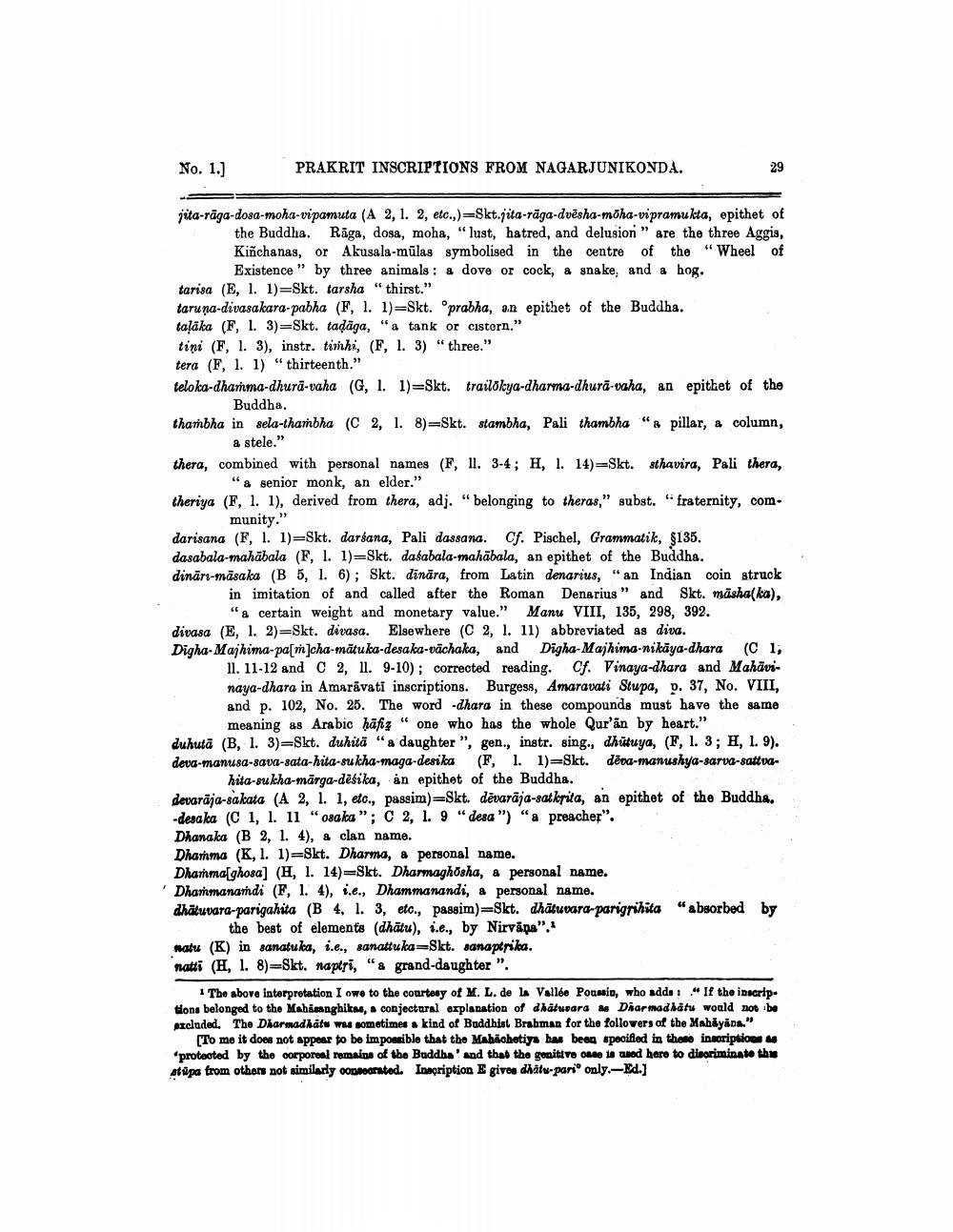________________
No. 1.)
PRAKRIT INSCRIPTIONS FROM NAGARJUNIKONDA.
29
jita-rāga-dosa-moha-vipamuta (A 2, l. 2, etc.,)=Skt. ita-räga-dvēsha-moha-vipramukta, epithet of
the Buddha. Rāga, dosa, moha, "lust, hatred, and delusion" are the three Aggis, Kiñchanas, or Akusala-mūlas symbolised in the centre of the "Wheel of
Existence" by three animals: a dove or cock, a snake, and a hog. tarisa (E, 1. 1)=Skt. tarsha "thirst." taruna-divasakara-pabha (F, 1. 1)=Skt. prabha, an epithet of the Buddha. taļāka (F, I. 3)=Skt. tadāga, "a tank or cistern." tini (F, I. 3), instr. timhi, (F, 1. 3)"three." tera (F, 1. 1) "thirteenth." teloka-dhamma-dhurā-vaha (G, I. 1)=Skt. trailokya-dharma-dhurā-vaha, an epithet of the
Buddha. thambha in sela-thambha (C2, 1. 8)=Skt. stambha, Pali thambha "& pillar, a column,
a stele." thera, combined with personal names (F, 11. 3-4; H, 1. 14)=Skt. sthavira, Pali thera,
"& senior monk, an elder." theriya (F, 1. 1), derived from thera, adj. " belonging to theras," subst. "fraternity, com
munity." darisana (F, I. 1)-Skt. darsana, Pali dassana. Cf. Pischel, Grammatik. $135. dasabala-mahābala (F, I. 1)=Skt. daśabala-mahābala, an epithet of the Buddha. dinār-māsaka (B 5, 1. 6); Skt. dināra, from Latin denarius, "an Indian coin struck
in imitation of and called after the Roman Denarius" and Skt. mäsha(ka),
"a certain weight and monetary value." Manu VIII, 135, 298, 392. divasa (E, 1. 2)Skt. divasa. Elsewhere (
C2, l. 11) abbreviated as diva. Digha Majhima-pa[m]cha-mätuka-desaka-vāchaka, and Digha-Majhima-nikāya-dhara (C1,
11. 11-12 and C 2, 11. 9-10); corrected reading. Cf. Vinaya-dhara and Mahavsnaya-dhara in Amarāvati inscriptions. Burgess, Amaravati Stupa, p. 37, No. VIII, and p. 102, No. 25. The word "dhara in these compounds must have the same
meaning as Arabic hafiz “ one who has the whole Qur'an by heart." duhutā (B, 1. 3)=Skt. duhita "a daughter ", gen., instr. sing., dhütuya, (F, 1. 3; H, L. 9). deva-manusa-sava-sata-hita-sukha-maga-desika (F, 1.1)=Skt. dépa-manushya-sarva-sattva
hita-sukha-märga-desika, in epithet of the Buddha. devarāja-sakata (A 2, l. 1, etc., passim)=Skt. devarāja-satkrita, an epithet of the Buddha. desaka (C1, 1. 11 “osaka"; C 2, 1. 9 “desa") "a preacher". Dhanaka (B 2, 1.4), & clan name. Dharma (K, 1. 1)-Skt. Dharma, a personal name. Dhamma[ghosa] (H, I. 14)=Skt. Dharmaghosha, a personal name. Dharmanamdi (F, 1. 4), i.e., Dhammanandi, & personal name. dhätuvara-parigahita (B 4, 1. 3, etc., passim)=Skt. dhātuvara-parigrihita "absorbed by
the best of elements (dhātu), i.e., by Nirvana".! watu (K) in sanatuka, i.e., sanattuka=Skt. sanaptrika. natti (H, 1. 8)Skt. naptri, "a grand-daughter".
1 The above interpretation I owe to the courtesy of M. L. de la Vallée Poussin, who adds : " If the inscriptions belonged to the Mahisanghikne, conjectural explanation of dhatuvara M Diaradhatu would not be Axcluded. The Dharmadhatw ww sometimes a kind of Buddhist Brabman for the followers of the Mahayana."
(To me it does not appear to be impossible that the Mahachotiys has been specified in there insoriptions protected by the corporeal remains of the Buddha' and that the genitive cute 16 uued here to discriminate the at üpa from others not similarly ooppocrated. Inscription E give dhatu pari only.-Ed.)




